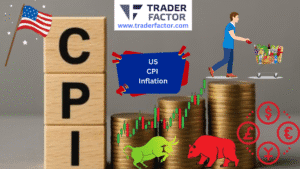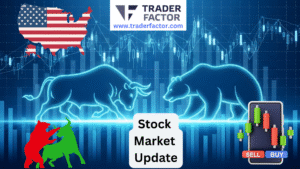
Markets Brace for CPI Data After Mixed Economic Signals
Global financial markets are displaying cautious sentiment as traders prepare for today’s CPI data and await the impact of the latest inflation report. Yesterday’s PPI

Global financial markets are displaying cautious sentiment as traders prepare for today’s CPI data and await the impact of the latest inflation report. Yesterday’s PPI

The global forex market is in a holding pattern as traders and investors brace for critical PPI inflation data. The focus today is squarely on

Gold price continued impressive ascent during Tuesday’s Asian trading session, reaching another all-time high as market participants eagerly await the Federal Reserve’s upcoming policy decision.

Investors are bracing for a pivotal week. Indeed, key inflation data is expected, and this will likely influence the Federal Reserve’s policy. Specifically, the focus

The US Non-Farm Payrolls (NFP) report is a key economic indicator.It shows the number of new jobs created. This excludes farm workers, private household employees,

US stock markets delivered mixed results on Wednesday, September 3, 2025, as technology giants powered gains in the Nasdaq while energy stocks weighed on broader

Gold price today have surged to unprecedented levels, reaching a record high of $3,546 per ounce as investors closely monitor gold price today and respond

The Bitcoin price USD is currently trading around $108,400 to $108,700 across major exchanges in live trading sessions, struggling to move above the $110,000 resistance

In this week’s market outlook, traders are turning their attention to two key data releases: the Job Openings and Labor Turnover Survey (JOLTS) and the

September 2025 marks another milestone month for Coinbase, America’s largest cryptocurrency exchange. Three exciting new listings are set to reshape how traders and investors approach

If you’re searching for an up-to-date “Binance new listings alert” or want to stay ahead of “upcoming coin listing on Binance” events, September 2025 is

The Core PCE Price Index remains a critical economic indicator for investors and policymakers. Today’s August 2025 release is expected to show a 0.3% monthly
An economic calendar is a schedule of important economic events and announcements released by government agencies, central banks, and other organizations around the world. The purpose of an economic calendar is to provide traders, investors, analysts, and other market participants with a comprehensive overview of important economic and financial data, and events that are likely to affect financial markets and asset prices.
Economic calendars typically include information such as the release date and time, the nature of the event, the expected outcome or forecast, and the historical data for comparison. By using an economic calendar, individuals can plan their trading strategies, monitor market volatility, and make informed investment decisions, based on the latest economic information.
Tracking economic events is crucial for anyone who invests or trades in financial markets. Here are some reasons why:
Tracking economic events is essential for investors day traders, investors decide anyone who wants to make informed decisions when investing or trading in financial markets. By staying up-to-date on economic news and trends, traders and investors can stay ahead of the curve and make informed investment swing trading decisions that are likely to lead to better returns.
There are several major economic indicators that are closely watched by investors, traders, fundamental analysts, and economists around the world. Here are some of the most important ones:
This value is the total value of goods and services produced in a country over a specific, long period of time. It is considered the most important measure of a country's economic health.
This measures the change in prices of a basket of goods and services purchased by households. It is used to measure inflation, which can have a significant impact on markets.
This measures the percentage of the labor force that is unemployed but actively seeking employment. It is an important indicator of the health of a country's job market. Also Nonfarm Payrolls (NFP) are important indicators of the job market.
This measures the value of total sales at retail stores in a country. It is an important indicator of consumer and business confidence and spending, which drives economic growth.
This measures the trend in the value of the output of manufacturing, mining, and utilities sectors in a country. It is an important indicator of the future performance and value of a country's trade and industrial sector.
PMII (Purchasing Managers' Index) and ISM (Institute for Supply Management) are two closely related economic indicators that measure the health of the manufacturing sector in a particular country.
The PMI is a monthly survey of purchasing managers in the manufacturing industry, conducted by an independent firm on behalf of companies of various business and trade, and business, trade, and organizations around the world.
The survey asks about new orders, production, employment reports, supplier deliveries, and inventories, and generates an index score between 0 and 100. A score above 50 indicates that the manufacturing sector is expanding, while a score below 50 indicates contraction.
The ISM Manufacturing Index is a similar monthly survey of purchasing managers in the United States manufacturing industry, conducted by the company the Institute for Supply Management. Like the PMI, it provides an index score between 0 and 100, with a score above 50 indicating expansion and a score below 50 indicating contraction.
Both the PMI and ISM Manufacturing data Index are considered leading indicators of the health of the manufacturing sector, as they can provide insight into future levels of growth, production, employment, and investment. They are closely watched by investors, traders, companies, businesses themselves, and economists, as changes in these indexes can affect financial markets, stocks and asset prices.
This measures the number of new residential construction projects that have begun in a country. It is an important indicator of the health of the housing market.
Interest rates play a crucial role in the economy and are closely watched by investors, economists, many traders, companies, and policymakers. Changes in interest rates can have a significant impact on financial markets, asset prices, stock, company profits, and the overall health of the economy.
This measures the difference between a country's exports and imports. A positive trade balance (more exports than imports) is generally seen as a sign of economic strength.
These are just a few of the major economic indicators that are closely watched by equity market participants. By tracking these indicators, investors, traders, and economists can get a better understanding of the overall health, financial performance, future growth prospects of stocks and a country's economy and make informed decisions about their investments and trades.
The economic calendar typically contains the following components:
These components provide traders, investors, and economists with a comprehensive overview fundamental analysis of upcoming economic events and announcements, as well other factors such as a trend analysis of their potential impact on financial markets. By using an economic calendar, individuals can plan their trading strategies, monitor market volatility, and make informed decisions based on the latest economic information.
Interpreting economic calendar data is crucial for traders, investors, fair market makers, and economists who want to make informed business decisions based on the latest economic information. Here are some key factors to consider when interpreting economic calendar data:
Interpreting economic calendar data fair market value requires a keen understanding and analysis of economic indicators, their significance, and their impact on financial markets and broader economy. By using this information, traders, investors, and economists can make informed business, trade, and investment decisions and capitalize on potential trading and investment opportunities.
Trading strategies based on economic calendar data can be used by traders and investors to capitalize on potential market movements and generate profits. Here are some common trading strategies that can be used:
This trading style and strategy and this trading strategy and style of investing involves risk identifying trends chart patterns in a few days of the market swing trading and entering trades in the opposite direction of those trends. Economic data can help identify trends, as positive data can indicate a bullish trend, while negative data can indicate a bearish trend.
This trading strategy for stocks often involves entering trades based on price action in equity, or on the release of economic data. Traders' trading strategy may enter positions before the release or equity price move of important economic data, in anticipation of any equity market volatility, or immediately after the release of the data or equity price move, to take advantage of sudden stock price movements.
This investment strategy also involves identifying support and resistance levels in the stock market and entering trades when the stock's current price approaches these levels. Economic data can help identify potential support and resistance levels for stock, as positive data may act as a support level, while negative data may act as a resistance level.
This strategy involves entering trades when the price breaks through a key support or resistance level. Economic data can help identify potential breakout levels, as positive data may signal a breakout above a resistance level, while negative data may signal a breakdown below a support level.
This investment strategy involves taking long-term positions in a company or stock, based on fundamental analysis of the company and economic data and trends.
Traders may enter positions in a stock or company or stock or stocks based on long-term economic indicators, such fundamental factors such as GDP growth rates or inflation rates, and hold those stocks or company or positions for an extended period of time.
Trading strategies based on quantitative and fundamental analysis alone, trading strategy used on technical analysis and fundamental analysis, and trading strategy used on economic calendar data require a deep understanding of fundamental analysis and quantitative analysis of economic indicators, financial markets, and trading techniques.
By using this information, traders and investors can make informed investment decisions and capitalize on potential trading opportunities. However, it's important to remember that trading always carries a risk, and traders should carefully consider their risk tolerance and investment goals before entering any trades.
There are several sources of economic calendar data available for traders, investors, and economists. Some of the most popular sources include:
Many online trading platforms offer economic calendar data as a built-in feature. These calendars are often customizable and can be filtered by country, date, price and importance level.
Websites such as Bloomberg, Reuters, and CNBC provide up-to-date economic calendar data, along with analysis and commentary on the potential impact of each release.
National governments and companies often publish their company their own economic calendars, income statements and financial reports, which include data releases specific to their company's earnings or the company or country.
For example, the U.S. Bureau of Labor Statistics publishes a monthly economic calendar that includes data on employment, inflation, trade data, and other key economic data indicators.
Companies such as Trading Economics and Econoday provide economic calendar and stock data as a paid service. These providers often offer detailed historical data on stocks, as well as real-time updates on stock move and alerts on stock move.
Central bank meetings such as the U.S. Federal Reserve and the European Central Bank publish economic calendars that highlight upcoming monetary policy decisions, speeches by central bankers, and other important events.
There are many sources and different perspectives of economic calendar data and it's important for traders, investors, swing traders, and economists to choose a reliable source that meets their specific needs.
By staying up-to-date on economic calendar data and other technical and fundamental analysis, individuals can make informed decisions and stay ahead of market trends.
An economic calendar can be a useful tool for traders, investors, and economists who want to stay up-to-date on important economic data releases and events. Here are some tips for using an economic calendar effectively:
By following these tips, individuals can use an economic calendar effectively to further financial performance, stay informed about important economic data releases and events, make informed decisions about future prospects for stock prices and their future cash flow, and capitalize on market moving events and potential trading opportunities.